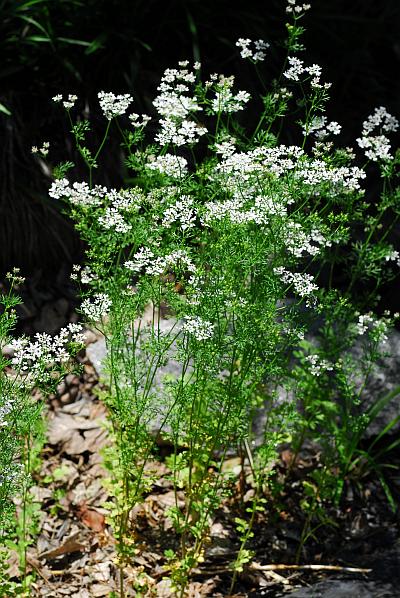Coriandrum sativum L.
Coriander

Introduced
CC = *
CW = 5
MOC = 4
© SRTurner
Coriandrum sativum L.Coriander | |
 |
Introduced CC = * CW = 5 MOC = 4 |
© SRTurner |
|
Family - Apiaceae Habit - Annual forb. Stem - Ascending to erect, to 70 cm, glabrous. Bruised vegetation strongly aromatic.
Leaves - Basal and alternate, with a few basal leaves usually present at flowering, glabrous. Basal and lower stem leaves mostly long-petiolate, the median and upper leaves short-petiolate or sessile, the sheathing bases not or only slightly inflated. Leaf blades 3-15 cm long, narrowly oblong to broadly ovate in outline, those of the basal and lowermost stem leaves usually 1 or 2 times pinnately compound, the leaflets 10-20 mm long, broadly obovate to fan-shaped, narrowed at the base, palmately toothed or lobed, rounded or bluntly pointed at the tip; those of the median and upper stem leaves progressively more divided, 2-3 times pinnately dissected, the ultimate segments linear, entire or with few teeth or lobes, mostly sharply pointed at the tip.
Inflorescence - Compound umbels, terminal and axillary, mostly long-stalked. Involucre absent or of 1 inconspicuous bract, this shorter than the rays, spreading at flowering, linear, with a sharply pointed tip. Rays 2-8, 1.0-2.5 cm long. Involucel of 3-5 bractlets, these shorter than to longer than the flower stalks and unequal in size, linear, and sharply pointed at the tip.
Florets - Flowers 11 to numerous in each umbellet, the stalks 2-5 mm long. Sepals mostly minute triangular teeth, but those of the outermost flowers of each umbellet usually somewhat enlarged, to 1 mm long, narrowly ovate. Petals obovate, rounded or shallowly notched at the tip, white or pale pink, some or all of those of the outermost flowers of each umbellet enlarged to 4 mm long, narrowly obovate, rounded at the tip, spreading. Ovaries glabrous.
Fruits - Schizocarps 1.5-2.5 mm long, broadly oblong-elliptic to nearly circular in outline, not flattened, glabrous, brown with pale ribs, the mericarps not or tardily separating, with 5 low, narrow, blunt ribs lacking wings and sometimes also with faint additional ribs.
Flowering - May - June. Habitat - Railroads and open, disturbed areas, usually escaped from cultivation. Origin - Native to Eurasia. Lookalikes - None close. Other info. - This species is uncommon in Missouri, with the few collections probably representing either escapes from cultivation or seed deposited by passing trains. It can reseed itself and persist for a number of years, but in our area it is not a particularly strong competitor. It is likewise sporadic and widely scattered across the continental U.S. The plant is easily recognized by its strongly dimorphic leaves which are aromatic when crushed, and its white florets. The florets are also dimorphic, with those at the perimeter of the umbellets having much expanded petals which spread outward.
Photographs taken near Labadie, Franklin County, MO, 5-21-2017 and 6-5-2020 (SRTurner). |